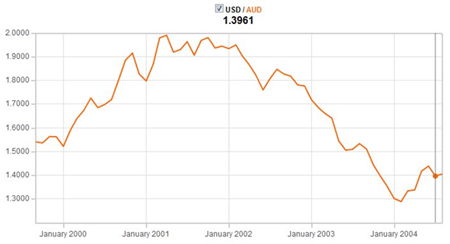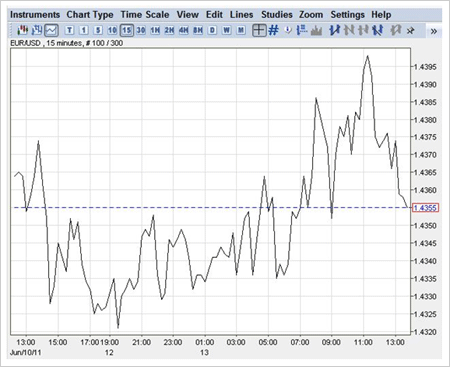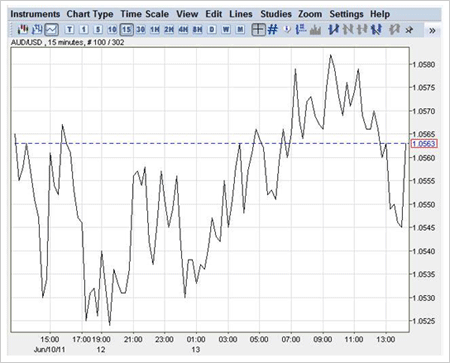The FOREX market is the most traded financial market in the world. Every day there is an estimated $4 trillion dollars worth of currencies exchanged around the world. You can trade this market 24 hours a day, 5 days a week, since it is not run from one country’s centralised location. It is the most liquid market with traders having the ability to make low cost and highly leveraged transactions. But what exactly is the FOREX? Can you really make money from it? What are some of the terms frequently used? Is the FOREX right for you?
What is the FOREX?
FOREX stands for ‘foreign exchange’ and refers to the market where currencies are traded. You likely have used the FOREX market indirectly without even knowing it.
For example, if you travel from Australia to the US, you no doubt needed to trade your Aussie money into US dollars. The bank performed the trade with an exchange rate. When returning home, you traded your American dollars back into the local Australian currency. But while you were on vacation, the exchange rate fluctuated slightly. You may have received a little more or a little less per Australian dollar exchanged. This is a simple example of currency exchange.
Although there are a lot of terms that we will deal with later such as spreads and pips, keep it in the back of your mind that FOREX is the simple process of exchanging one currency for another.
How the FOREX Works / FOREX Explained
The concept behind the FOREX is that each country’s currency has a changing relative value when compared to another nation’s money. If inflation runs wild in one country, its value will be reduced when compared to another country with economic stability. While the FOREX trades fiat currency, you are really trying to determine which economy will improve or decline in comparison to another.
How do you determine the health of an economy?
This is usually done by examining the economic policy of the government and central bank, or by reading economic reports and other widely disseminated indicators. You may look at employment levels, the trade surplus or deficit, inflation rates, interest rates, budget deficits, and economic productivity of a nation. The stability of the government also factors in as risk. The relative value of a currency is simply a reflection of how others perceive the country’s economic health and stability. Examine how the relative value of US and Australian dollars changed before and after September 2001. We will discuss how to read a chart later on.

Without going into great detail, the US dollar weakened over the few years following the US disaster in September 2001. Or you could also say that the Australian dollar strengthened since it’s all relative between the two currencies.
Recall that the FOREX market is a de-centralised over-the-counter marketplace that facilitates an international trading of money. Banks, institutions, and individual traders all have access to this giant market of exchanging currencies. Now that we see the big picture of what the FOREX market is, how do you actually trade on the FOREX?
Trading Currency Pairs
To begin with, you need two currencies to trade with which are referred to as a currency pair. You will be trading from one currency to the other, and then back again to close the trade. Certain currency pairs are very popular and are referred to as ‘majors’. These seven majors make up an estimated 75-80% of the FOREX trading volume. Here are the majors:
- EUR/USD – EURO/U.S. Dollar
- GBP/USD – British Pound/U.S. Dollar
- USD/JPY – U.S. Dollar/Jananese YEN
- USD/CHF – U.S. Dollar/Swiss Franc
- USD/CAD – U.S. Dollar/Canadian Dollar
- AUD/USD – Australian Dollar/U.S. Dollar
- NZD/USD – Zealand Dollar/U.S. Dollar
Note that all the majors include the U.S. Dollar. However, you can also trade non-U.S. pairs from those listed in the majors. These are called ‘cross currency’ pairs. They include:
- EUR/AUD – EURO/Australian Dollar
- CAD/GPY – Canadian Dollar/Japanese YEN
- GBP/CHF – British Pound/Swiss Franc
There are numerous other currency pairs to trade that include one of the currencies from the majors and a lesser traded currency. The CAD/NOK – Canadian Dollar/Norway Kroner is one such example.
How to Read FOREX Quotes
A simple way to think of the currency pair exchange is buying one currency while selling another. For example, depending on how you trade, the first currency listed is the money which you are selling and the second currency is the money that you are buying. The first currency is called the ‘base’ currency while the second is called the ‘counter’ or ‘quote’ currency.
- Take the quote AUD/USD 1.0565
The base currency is the Australian dollar. Its value is always 1. Therefore, 1 Australian Dollar is equal to 1.0565 U.S. Dollars. Thus, the Australian Dollar is worth more. You will be less concerned with the absolute values and more focused on the changing relative values. How does the changing value of this number mean?
- If the quote changes downwards, say to AUD/USD 0.75, this means that the U.S. Dollar has strengthened and that the Australian Dollar has weakened. It now takes less U.S. money to buy one Australian dollar.
- If the quote changes upwards, say to AUD/USD 1.50, this means that the U.S. Dollar has weakened and the Australian Dollar has strengthened. It takes more U.S. money to buy one Australian dollar.
As a quick short-cut, if the number goes up you know that the first listed currency is strengthening. If the number drops, you know that the second listed currency is strengthening.
The Bid and the Ask
You will notice that there are actually two sets of numbers when reading the quotes.
- The first number, 1.0565, is called the bid. This is how much you can sell the base currency for.
- The second number, 1.0569, is the ask. This is how much you can buy the base currency for.
The difference between the two is called a spread. You will need to buy at the higher price can sell at the lower price. Or you can sell first and buy later. Either way you will lose a certain amount of money if you quickly buy and sell. This difference is called a spread. The units of difference have their own term called a pip.
What is a Pip?
A pip is the smallest unit that a currency can trade for. If the currency is listed up to 4 decimal places, then the last decimal place is called a pip. In the above example of the AUD/USD, there is a spread of .0004. Therefore, there is a 4 pip spread between the bid and the ask on the FOREX price quotes.
Note that when using the Japanese YEN, a pip is the second decimal place.
The bid is 84.78 while the ask is 84.84 and the spread is 6 pips. One Australian dollar can be immediately be sold for 84.78 YEN. If you want to buy back, you will need to need 84.84 YEN or a 6 pip loss. If you quickly trade back and forth without any price movement, you will lose the value of the spread.
The amount of pips between the bid and the ask is determined by how many market players are trading the pair and the amount of volume or dollars which they are trading. The more liquid the currency pair is, the tighter the spread will be.
How Much is a Pip Worth?
The value of the pip depends on the currency being traded. It is important to know which currency is on the counter, or the right hand side of the quote. Let’s look at an example of this:
Each pip in this example represents $1 U.S. dollar if we are trading a mini contract. Why? It relates to our contract size. Here are the contract sizes:
- Standard contract size: 100,000 currency units
- Mini contract size: 10,000 currency units
- Micro contract size: 1,000 currency units
Simply multiply your contract size by the pip to get the value. If one pip equals 0.0001, and you have a contract size of 10,000, then 10,000 x 0.0001 = $1 US dollar. One pip equals $10 in a standard contract size and only 10 cents in a micro contract.
So if you quickly bought and sold the above AUD/USD currency pair with a standard contract, you would instantly be down 4 pips or $40 dollars.
How to Make Money Trading the FOREX
You have two options with the currency pair: to trade long or short.
- If you trade long on the currency pair you make money when the quote rises. You will lose money when the listed quote drops.
- If you trade short on the currency pair you will make money when the quote drops. You will lose money if the listed quote rises.
Another way to look at this is to examine both currencies, the ones listed on the left and the right. If you think the currency on the left with strengthen, then buy a contract and make money when the number rises. If you feel the currency on the left will strengthen, sell a contract and make money when the number drops.
How much money will you need to trade with? It will largely depend on how much margin and leverage you use.
Using Margin and Leverage When Trading
You can typically get trading leverage of 50, 100, or 200 to 1 when trading the FOREX market. This means that for every dollar of your own money, you can trade with 50, 100, or 200 dollars.
To determine the exact amount of leverage you are using, divide the total amount of the position by the amount of money in your account. If your total position is worth $100,000 and your account has $10,000 in it, then you have a leverage of 10.
If you were allowed up to 200:1 leverage, then you would only need $500 to open this position. Remember though that leverage works in both directions. If the currency pair trades 50 pips for you in a standard contract, you would double your small investment. If the trade goes 50 pips against you, the account is wiped out.
These are the basics for FOREX trading. Next we will consider whether you can really make money trading FOREX successfully and some cautions.
Making Money Trading the FOREX
I have read various statistics about the amount of FOREX traders that lose money. While it is hard to find a reliable source for this, the consensus seems to be in the 90% plus range for money losers. This means that less than 10% of currency traders make money. Why do so many FOREX traders lose money?
The in-depth answer to that is beyond the introductory scope of this article, but here are a few brief reasons why:
- Not properly analyzing win/loss ratios: Some setups are highly profitable…when they happen. For instance, some use a certain indicator to trade against the trend. When the market changes direction, this can be wildly profitable. However, more often than not the currency pair will trade in a direction for some time and reversals are quite infrequent. If you only win 35% of the time, you will likely be a losing trader.
- No Risk Management: You should have a profit and a stop-loss target in mind. Many FOREX traders expect too much out of each transaction. They have no clear plan to take a profit or to cut losses short. In fact, many will ‘double-down’ when a trade goes against them.
- Overtrading: Overtrading can kill your accounts by draining them slowly by the spread. Why do people overtrade? Perhaps because they are bored and there is not a suitable setup, or perhaps because they are not even following a trading strategy. You should have a strategy and stick to it.
It is definitely possible to make money in the FOREX. But you should enter into it cautiously, experiment with different strategies using simulators and practice accounts until you have a system that works enough of the time to generate acceptable profits. If you have dreams of grandeur and making huge sums from little effort, you will probably be one of the majority that are quickly disappointed with a drained account.
FOREX Trading Examples
i. You want to trade the currency pair EUR/USD. You use standard contract sizes of 100,000. You are selling 100,000 EUROs in exchange for 100,000 U.S. dollars. The quote is EUR/USD 1.4355/1.4359. You feel that the U.S. economy will continue to strengthen and thus the number will drop.

In this example we will assume you have the equivalent to $1,000 EUROs in your account. To trade one contract you will need leverage of 100:1 since you are trading a standard contract of 100,000. You feel that the chart will continue to drop.
So you sell (go short) one standard contract. You sell 100,000 EUROS and convert it into U.S. dollars. This translates into 143,550 U.S. dollars. Suppose the value drops to 1.4350/1.4354. You buy back at the rate of 1.4354. Recall that your sell rate is the first quote and your buy rate is the second quote. You made a profit of 1 pip. 1 pip is worth $10.
ii. You next decide to trade between the AUD/USD. The rate is 1.0563/1.0567. The first is the sell rate and the second is the buy rate. You think that the Australian dollar will continue to strengthen so you initiate a long position by purchasing AUD with USD.

You purchase a mini contract which involves 10,000 currency units. You buy at 10,000 AUD at a rate of 1.0567. You have 200:1 leverage so you need to only have the equivalent of $52.835 US to initiate this instead of the full $10,567.
The AUD strengthens as the rate drops to 1.0535/1.0539. You buy back or cover your position at the higher rate of 1.0539. Your profit is 28 pips. Because you are trading a mini contract this is worth $28 dollars. This is a 53% profit despite being small.
FOREX Wrap-up
Trading FOREX successfully takes time, patience, discipline and skill. Of course, the first step is learning the basics and the lingo. Next you need to take the plunge and practice, even with virtual dollars, until you feel comfortable with the trading process. As you experiment with different systems ranging from the fundamental to the technical, you will gain a measure of confidence that will eventually allow you to trade with real money and increasingly larger amounts.
As you trade the rapidly changing economy by using the FOREX exchange, you will enter into one of the most exciting and well used markets in the world.